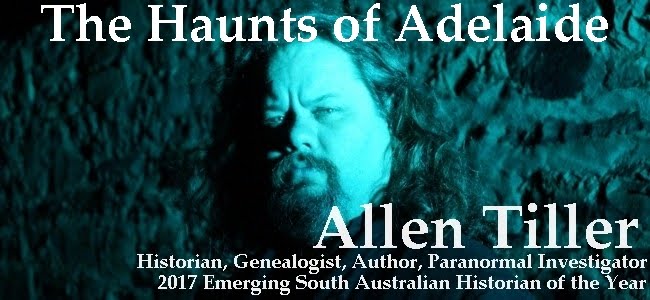The Haunts of Adelaide and the “Haunted Adelaide” blog
celebrates 4 years this week on the 22nd of October 2016.
Every week I have presented a historical story, fact, ghost
story, murder story or mystery from South Australia. The blog has seen dramatic
rises in reader rates over the past couple of years, particularly stories about
the towns of Gawler and Kapunda.
 |
| photo by James Levett Photography |
In the past four years I have been approached and
interviewed by various media outlets in Adelaide looking for information on
murders, hauntings and other notable “dark history” content, most recently it
was The Advertiser, who approached me for comment about ghosts in Rundle Mall
for their “40-year anniversary special”. It is always a privilege to be able to
share my research with such respected journalists and a wider audience.
Two years ago I
published my first book, The Haunts of Adelaide: History Mystery and the
Paranormal, which can now be found in libraries across Australia, but also
still available online or from Dymocks in Rundle Mall.
Earlier this year, I spent four months working with the
Adelaide City Council researching and investigating the history of ghosts and
hauntings in the Council catchment, this project was incredibly popular, and a world
first Government engagement of its kind!
I would very much like to thank all the wonderful people who came in to share stories, City Library and North Adelaide Library,
My research work from that particular project can be found on the Adelaide City Council Libraries History Hub collections under the “Allen Tiller Collection” – there is more to come soon!
I would very much like to thank all the wonderful people who came in to share stories, City Library and North Adelaide Library,
My research work from that particular project can be found on the Adelaide City Council Libraries History Hub collections under the “Allen Tiller Collection” – there is more to come soon!
This particular project led to, what has been my highlight of the year so far, being nominated for the “Emerging Historian of the Year” category in the annual History Council of South Australia’s history awards, a big thank you to Katherine Shaw for nominating myself and the Haunted Buildings in Adelaide Project”.
The Haunted Buildings
in Adelaide project has led to a new project, this time for the Port Adelaide
Enfield Council, researching number of their haunted buildings for a special
Halloween release!
 In the mean time I am
working on a number of other project behind the scenes, including a follow up
book to the Haunts of Adelaide, this one is taking much longer than anticipated
as new research avenues have opened up to me, and through them, I am able to
provide a much more concise view of the history surrounding hauntings in some
of South Australia’s most notorious hauntings...this book will also feature a
number of “True Stories” never before heard by the South Australian public.
In the mean time I am
working on a number of other project behind the scenes, including a follow up
book to the Haunts of Adelaide, this one is taking much longer than anticipated
as new research avenues have opened up to me, and through them, I am able to
provide a much more concise view of the history surrounding hauntings in some
of South Australia’s most notorious hauntings...this book will also feature a
number of “True Stories” never before heard by the South Australian public. If you liked my first book, I am sure you’ll enjoy this one much much more!
It has been an enormous year for Haunted Adelaide, and The
Haunts of Adelaide, hopefully I can keep the momentum going and write more
interesting and entertaining blogs for you all to read and explore the
alternative history of South Australia, until next time…
Happy Hauntings :)
Allen Tiller
www.allentiller.com.au









